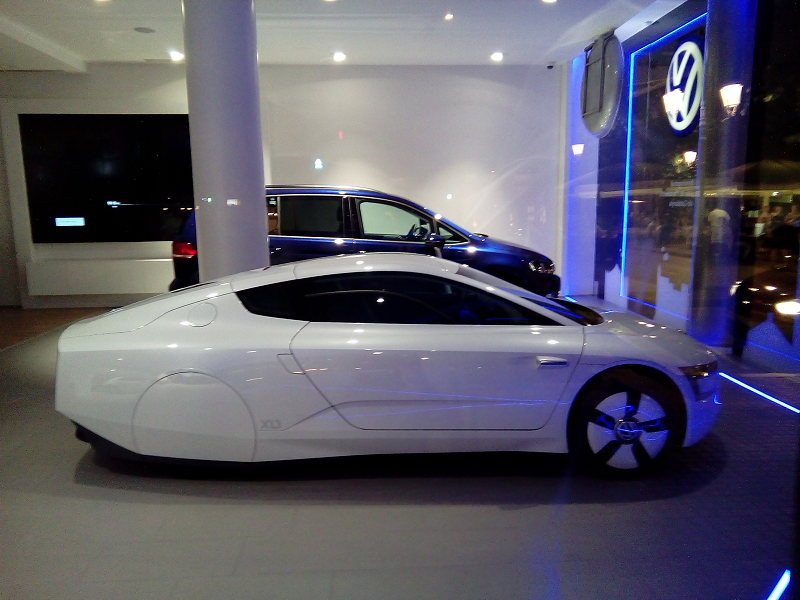VOLKSWAGEN: XL1 white concept
The Volkswagen XL1 (VW 1-litre) is a two-person limited production diesel-powered plug-in hybrid produced by Volkswagen. The XL1 car was designed to be able to travel 100 km on 1 litre of diesel (280 mpg‑imp; 240 mpg‑US), while being both roadworthy and practical.
To achieve such economy, it was produced with lightweight materials, a streamlined body and an engine and transmission designed and tuned for economy. The concept car was modified first in 2009 as the L1 and again in 2011 as the XL1.
A limited production of 250 units began by mid 2013 and pricing started at €111,000 (~ £119,000). The Volkswagen XL1 plug-in diesel-electric hybrid was available only in Europe and its 5.5 kWh lithium-ion battery delivered an all-electric range of 50 km (31 mi), had a fuel economy of 0.9 L/100 km (310 mpg‑imp) under the NEDC cycle and produced emissions of 21 g/km of CO2. The XL1 was released to retail customers in Germany in June 2014.
The prototype VW 1-litre concept car was shown to the public in April 2002 when Ferdinand Piëch, then chairman of the board of management, drove the concept between Wolfsburg and Hamburg as part of the Volkswagen annual meeting of stockholders.
For aerodynamics, the car seats two in tandem, rather than side-by-side. There are no rear view mirrors and it instead uses cameras and electronic displays. The rear wheels are close together to allow a streamlined body. The total aerodynamic drag is minimal because both the drag coefficient and frontal area are small). The drag coefficient (Cd) is 0.159, compared to 0.30 – 0.40 for typical cars.
The external dimensions of the car are 3.47 m (11.4 ft) long, 1.25 m (4.1 ft) wide and 1.10 m (3.6 ft) tall. There is 80 L (2.8 cu ft) of storage space. The car features an aircraft-style canopy, flat wheel covers and an underbelly cover to smooth the airflow. The engine cooling vents open only as needed.
The body and frame are designed with crush/crumple zones and roll-over protection, and the tandem seating means large side crush zones. Volkswagen claims protection comparable to a GT racing car. The car has anti-lock brakes, airbags with pressure sensors, and stability control.
The engine is a one-cylinder 299 cm3 (18 cu in) diesel producing just 6.3 kW (8.4 hp). It drives through a six-speed transmission that combines stick-shift mechanics, weight, and drive efficiency with automatic convenience and efficiency controls. There is no clutch pedal. The gear selection (forwards, reverse or neutral) is made using a switch on the right-hand side of the cockpit. The engine is switched off automatically during deceleration and stops, and auto-restarted when the acceleration pedal is pressed.











